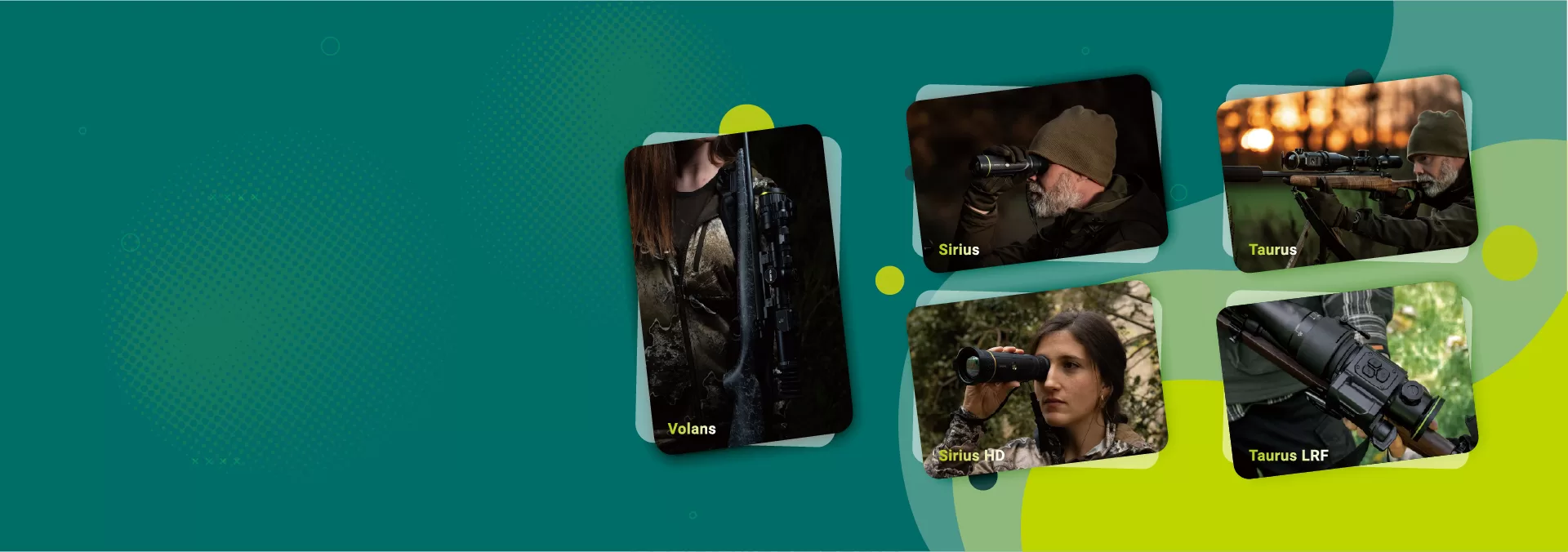To address the question of whether thermal scopes can see infrared, we must first understand the relationship between thermal imaging and the infrared spectrum. The electromagnetic spectrum encompasses radiation of varying wavelengths, from gamma rays (shortest) to radio waves (longest). Infrared radiation sits between visible light and microwave radiation on this spectrum, covering wavelengths from approximately 700 nanometers to 1 millimeter.
It’s crucial to recognize that infrared (IR) is a broad category that includes multiple sub-bands. Near-infrared (NIR) ranges from 0.7-1.4 μm, short-wavelength infrared (SWIR) from 1.4-3 μm, mid-wavelength infrared (MWIR) from 3-8 μm, and long-wavelength infrared (LWIR) from 8-15 μm. What we commonly call “thermal imaging” primarily operates in the MWIR and LWIR bands, detecting the heat signatures naturally emitted by objects,and this feature is a major advantage for hunters.
According to the International Commission on Illumination:
“All objects with temperatures above absolute zero emit infrared radiation. The wavelength distribution and intensity of this radiation are directly related to the object’s temperature.”
This scientific principle forms the foundation of thermal imaging technology. Modern thermal scopes like the Pixfra Pegasus Pro Series and Chiron LRF Series are specifically designed to detect and visualize MWIR or LWIR radiation, which corresponds to the heat signatures emitted by animals, humans, and objects in the environment. Therefore, thermal scopes do indeed “see” infrared radiation—specifically, the mid to long-wavelength infrared emissions that correspond to heat signatures.
The Technical Distinction: Active vs. Passive Infrared Technologies
An important technical distinction exists between the different technologies used to detect infrared radiation. This distinction helps clarify what exactly thermal scopes can and cannot detect in terms of infrared light.
Passive Infrared Detection (Thermal Imaging): Devices like the Pixfra Sirius Series Thermal Monocular use uncooled microbolometer sensors to detect naturally emitted infrared radiation (heat) without requiring any external light source. These operate primarily in the LWIR spectrum (8-14 μm) and create images based solely on temperature differences.
Active Infrared Technologies: These include night vision devices that actively project near-infrared light (NIR, 0.7-1.4 μm) to illuminate an area, similar to a flashlight that human eyes cannot see. This projected light is then detected by specialized cameras.
Near-Infrared Illuminators: These devices project NIR light that standard thermal scopes cannot detect, as they are tuned to detect MWIR and LWIR radiation instead.
| Technology Type | Wavelength | Requires Light Source | What It Detects | Pixfra Example |
|---|---|---|---|---|
| Thermal Imaging | 8-14 μm (LWIR) | No | Heat signatures | Pegasus Pro Series |
| Night Vision | 0.7-1.4 μm (NIR) | Yes (either ambient or IR illuminator) | Reflected NIR light | Volans Series (supports day/night use) |
| Daytime Optics | 0.4-0.7 μm (Visible) | Yes (natural light) | Reflected visible light | N/A |
This distinction explains why thermal imaging devices like the Pixfra Taurus Series Thermal Front Attachment can function in complete darkness without any external illumination—they detect the LWIR radiation naturally emitted by all objects with temperatures above absolute zero, rather than requiring reflected light of any kind.
Microbolometer Technology: The Heart of Modern Thermal Scopes
At the core of a modern thermal scope’s ability to detect infrared radiation is the microbolometer sensor technology. Understanding this component helps clarify what specific types of infrared radiation thermal scopes can detect and visualize.
Microbolometer sensors consist of arrays of microscopic detector elements made from materials (typically vanadium oxide or amorphous silicon) that change electrical resistance when exposed to infrared radiation. These minute resistance changes are measured, processed, and converted into a visible thermal image.
The sensitivity of these sensors is measured by Noise Equivalent Temperature Difference (NETD), expressed in millikelvin (mK). Premium thermal devices like the Pixfra Sirius HD Series feature sensors with NETD values of ≤18mK, indicating exceptional sensitivity to minute temperature differences—critical for detecting subtle thermal signatures at extended ranges.
Resolution also plays a vital role in a thermal scope’s capability to detect and display infrared radiation clearly. Higher resolution sensors like the 640×512 detector in the Pixfra Arc LRF Series provide more detailed visualization of thermal patterns compared to lower resolution alternatives.
According to thermal imaging expert Dr. Heinrich Müller from the European Institute of Thermal Science:
“Advancements in microbolometer technology have reduced NETD values from approximately 100mK in early commercial devices to below 20mK in current premium systems, representing a five-fold improvement in temperature sensitivity over the past decade.”
This technological advancement directly translates to improved detection capabilities for hunters and wildlife observers using thermal imaging equipment in challenging environmental conditions.
PIPS 2.0: Enhanced Infrared Detection Through Advanced Processing
While the physical sensor detects infrared radiation, the processing of this thermal data is equally crucial in determining what a thermal scope can effectively “see.” Modern thermal imaging systems incorporate sophisticated signal processing to enhance detection capabilities beyond what raw sensor data might provide.
Pixfra’s proprietary PIPS 2.0 (Pixfra Imaging Processing System) exemplifies how advanced processing algorithms can significantly improve the visualization of infrared data. This system enhances image clarity through multiple processing stages:
- Noise Reduction: Eliminates random variations in sensor readings that can obscure genuine thermal signatures
- Detail Enhancement: Accentuates subtle temperature gradations that might otherwise be missed
- Edge Definition: Improves the delineation between objects with different thermal signatures
- Range Optimization: Adjusts dynamic range to maintain visibility across varying temperature conditions
These processing enhancements effectively expand the range of infrared radiation that can be meaningfully detected and interpreted by the user. For instance, in challenging conditions like light fog or rain, which can partially attenuate LWIR radiation, processing algorithms can amplify subtle signals that might otherwise be lost.
The real-world impact of these processing capabilities is particularly evident in the field, where environmental conditions constantly change. A European Hunting Association field test found that:
“Thermal devices with advanced processing capabilities demonstrated up to 40% greater effective detection range in challenging environmental conditions compared to systems with similar sensors but less sophisticated signal processing.”
Detection Range: Factors Affecting Infrared Visibility
The ability of thermal scopes to detect infrared radiation at distance is influenced by multiple factors beyond just the sensor specifications. Understanding these factors helps users develop realistic expectations about detection capabilities in various scenarios.
Sensor Resolution: Higher resolution sensors (e.g., 640×512 vs. 384×288) provide more detailed infrared information at greater distances. The Pixfra Mile 2 Series offers options ranging from 256×192 to 640×512 resolution to address different detection range requirements.
Lens Specifications: Focal length and aperture significantly impact detection range. Longer focal length optics like the 50mm lens on the Pixfra Sirius S650 model provide greater magnification and detection range compared to shorter focal length alternatives.
Atmospheric Conditions: Water vapor, dust, and precipitation can attenuate LWIR radiation. High humidity, rain, and fog reduce effective detection ranges.
Target Size and Thermal Contrast: Larger targets with greater temperature differential from the background are detectable at greater distances. A typical detection range matrix might look like:
| Target Size | Thermal Contrast | Detection Range with 640×512 Sensor | Recognition Range |
|---|---|---|---|
| Large (Human/Deer) | High (>10°C) | 1,800-2,600m | 500-900m |
| Medium (Fox) | Medium (5-10°C) | 900-1,400m | 300-500m |
| Small (Rabbit) | Low (<5°C) | 400-700m | 150-250m |
These ranges represent optimal conditions and will decrease with adverse weather or when targets have minimal thermal contrast with their surroundings.
Infrared Reflectivity: What Thermal Scopes May Miss
While thermal scopes excel at detecting emitted infrared radiation (heat), they cannot detect certain infrared phenomena related to reflectivity rather than emission. This limitation is important for users to understand when considering the capabilities and constraints of thermal imaging equipment.
Thermal scopes cannot detect:
- Near-Infrared Illumination: IR illuminators used with night vision devices operate in the NIR spectrum (0.7-1.4 μm), which is outside the detection range of thermal imaging systems focused on LWIR radiation.
- IR Laser Aiming Devices: Infrared lasers used for target designation are invisible to thermal imaging systems.
- Reflected LWIR: Unlike visible light cameras that detect reflected light, thermal imagers detect emitted radiation. This means thermal scopes cannot “see” infrared light reflected off surfaces—only the heat those surfaces emit.
According to Dr. Anna Kowalski of the European Optical Systems Institute:
“The common misconception that thermal imagers can detect all infrared frequencies leads to unrealistic expectations. These devices are specifically tuned to detect emitted thermal radiation in the 8-14 μm range, making them blind to near-infrared illumination and laser systems operating in shorter wavelengths.”
This distinction is particularly important for professional users who might be operating in environments where multiple infrared technologies are in use simultaneously, such as in wildlife management or security applications.
Practical Applications: When Thermal Infrared Detection Excels
Understanding the specific infrared detection capabilities of thermal scopes helps users identify the optimal applications for this technology. Thermal imaging devices like the Pixfra Taurus LRF Series excel in scenarios that leverage their ability to detect mid and long-wave infrared radiation:
Wildlife Detection in Dense Vegetation: The LWIR radiation emitted by animals penetrates light vegetation more effectively than visible light, making thermal scopes superior for detecting wildlife in moderately dense cover.
Tracking After Shot: The residual heat signature left by game animals provides a distinct thermal trail that can be followed even when visible blood trails are difficult to detect.
Nocturnal Wildlife Management: For species active primarily during nighttime hours, such as wild boar, thermal detection capabilities enable effective population management without disturbing natural behavior patterns.
Environmental Hazard Identification: Thermal scopes can identify potential environmental dangers like forest fire hotspots that emit distinctive infrared signatures before they become visible to the naked eye.
The European Wildlife Management Consortium reports:
“In controlled field tests, experienced hunters using thermal imaging equipment demonstrated 78% higher detection rates of camouflaged wildlife compared to traditional optics, with the advantage increasing to 94% in low-light conditions.”
These practical advantages stem directly from the thermal scope’s ability to detect specific infrared wavelengths associated with heat signatures rather than relying on reflected visible light.
Conclusion: Understanding the Infrared Capabilities of Thermal Scopes
To directly answer the original question: Yes, thermal scopes do see infrared radiation—specifically, they detect mid and long-wavelength infrared radiation (MWIR and LWIR) that corresponds to heat signatures emitted by objects in the environment. However, they cannot detect near-infrared (NIR) illumination used by night vision devices or IR laser systems.
This specific infrared detection capability makes thermal imaging technology uniquely valuable for applications requiring the visualization of heat signatures regardless of lighting conditions. Modern thermal scopes like those in the Pixfra lineup combine sensitive microbolometer technology with sophisticated image processing to provide exceptional thermal infrared detection capability across diverse environmental conditions.
Understanding these technical capabilities and limitations allows users to make informed decisions about when thermal imaging technology represents the optimal solution for their specific requirements, whether for wildlife observation, hunting, or security applications.
Contact Pixfra for Advanced Thermal Imaging Solutions
If you’re interested in exploring how thermal imaging technology can enhance your hunting or observation capabilities, Pixfra offers a comprehensive range of products designed to meet diverse requirements and budgets. From the compact Mile 2 Series to the premium Pegasus Pro Series, our thermal imaging lineup delivers exceptional infrared detection capabilities backed by PIPS 2.0 processing technology.
For more information about our thermal imaging solutions or to discuss distribution opportunities in European markets, contact our specialists at info@pixfra.com or visit pixfra.com to explore our full product range and technical specifications. Our team can provide expert guidance on selecting the optimal thermal system for your specific application requirements, ensuring you maximize the benefits of this advanced technology.




